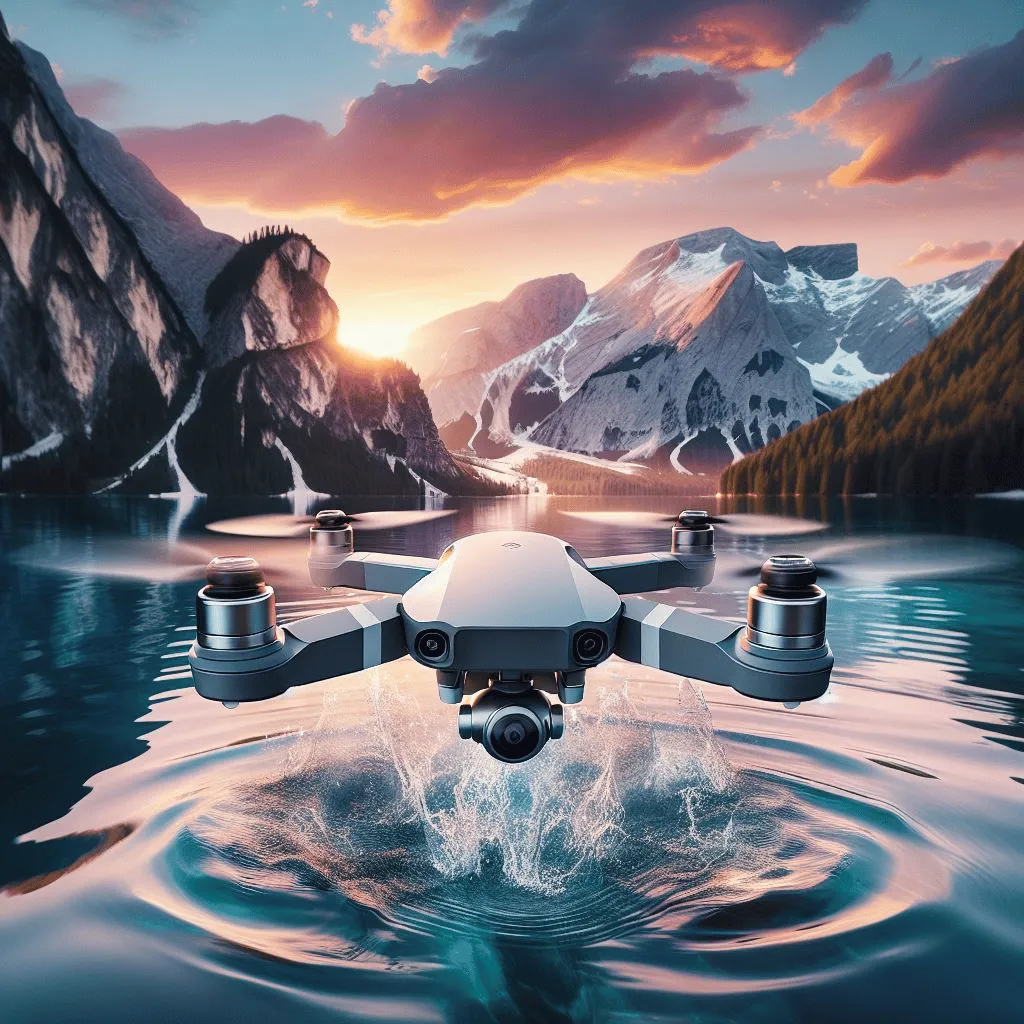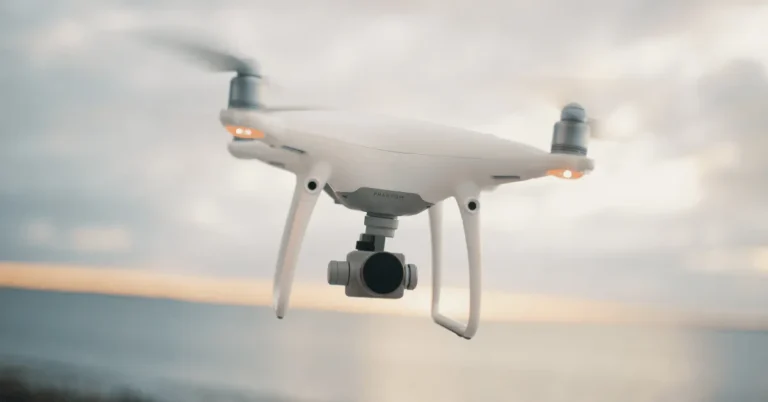Are Drones Waterproof? (Can They Fly in Watery Situation?)

Picture this: you’re out in the great outdoors, ready to capture some epic aerial shots with your trusty drone.
The sun is shining, the birds are chirping, and everything seems perfect… until it starts to rain. Panic sets in as you wonder, “Are drones waterproof?”
Well, fear not, dear drone enthusiasts, because we’re here to answer that burning question and save your precious flying machine from a watery demise!
Are drones waterproof?
That’s a good question, especially if you’re planning to fly your drone over a lake, a river, or even the ocean.
The answer is: it depends. Some drones are designed to be water-resistant, meaning they can withstand some splashes or raindrops, but not full immersion.
Other drones are fully waterproof, meaning they can survive being submerged in water, and some can even float on the surface.
And then there are the drones that are not waterproof at all, meaning they will be damaged or destroyed by any contact with water.
How can you tell which type of drone you have? Well, you can check the product specifications, look for an IP rating (which indicates the level of protection against water and dust), or watch some online reviews.

But the best way to find out is to avoid flying your drone near water in the first place, unless you’re absolutely sure it can handle it.
Because even if your drone is waterproof, there are other risks involved, such as losing control, crashing into obstacles, or attracting unwanted attention from wildlife.
So, unless you’re a professional drone pilot or a thrill-seeker, it’s better to be safe than sorry and keep your drone dry.
Read More: Can You Fly a Drone in The Rain? (My Best Tips)
How drones are waterproof?
You might think that drones are delicate devices that can’t handle a drop of water, but you’d be wrong.
Some drones are actually waterproof, meaning they can fly in the rain, land on water, or even dive underwater. How do they do it? Well, it’s not magic, it’s science.
The drone’s casing and propellers typically incorporate waterproof technology, with some models extending this feature to include waterproofing for their cameras.
Internal drone components, including the battery, motors, and electronics, are sealed to prevent water ingress and potential damage.
Some DIY enthusiasts even apply silicone conformal coating or anti-corrosion lubricant to their drones to make them more water-resistant.

Of course, not all drones are waterproof, so don’t go throwing your drone into a pool or a lake without checking first. You might end up with a wet and useless piece of junk.
And if you do get your drone wet, make sure you dry it properly and check for any signs of rust or corrosion.
Or better yet, buy a waterproof drone and enjoy flying in wet conditions without worrying about ruining your expensive toy.
Read More: Is DJI Mini 3 Pro Waterproof? || Tips & Tricks 2024
Are all drones waterproof or water resistant?
That’s a good question, especially if you plan to fly your drone over a lake or a pool. The answer is: it depends. Some drones are designed to be splash-proof or even submersible, while others are not.
You should always check the specifications of your drone before exposing it to water, or you might end up with a soggy and useless device. Remember: water and electronics don’t mix well, unless you’re a fish.
Can drones fly in rain?
Picture this: you’re all set to take your trusty drone out for a spin, but suddenly, ominous rain clouds start rolling in.
The big question looms: can drones fly in the rain? Well, my friend, the answer is a bit more complicated than a simple yes or no.
While some drones are equipped with waterproofing technology, allowing them to handle a light drizzle or a few raindrops, most consumer-grade drones are not designed to take on a full-blown rainstorm. Think of them as delicate creatures, preferring sunny skies and gentle breezes.
Water and electronics don’t usually mix well, and drones are no exception. Rain can damage the delicate circuitry, short-circuit the motors, or even cause the drone to lose control. So, it’s generally a good idea to keep your drone snug and dry when the heavens open up.
But fear not, fellow drone enthusiasts! There are a few tips and tricks you can follow to protect your drone from the rain’s wrath.

Tips & Tricks
First and foremost, check the weather forecast before taking flight. If there’s even a hint of rain, it’s best to postpone your aerial adventures.
If you find yourself caught in an unexpected shower, try to land your drone as quickly and safely as possible. Avoid flying near puddles or bodies of water, as a sudden dip could turn your drone into an unintentional submarine.
Remember, drones are not invincible, so it’s always better to err on the side of caution when it comes to rain. Keep your drone dry, and it will reward you with countless hours of aerial excitement in fairer weather.
So, can drones fly in the rain? The answer is a resounding “no, thank you.” Let’s leave the rainy skies to the ducks and embrace the sunny days for our drone adventures.
Read More: Is Autel Evo 2 Waterproof? (ANSWERED)
Can drones go underwater?
Well, that depends on what kind of drone you have. Some drones are designed to fly in the air, while others are built to dive in the water.
But don’t try to switch them around, or you might end up with a wet and useless gadget. Air drones have propellers that spin fast to create lift, but they would be too slow and inefficient to propel a drone underwater.
Water drones have propellers or fins that are shaped differently to move smoothly through the liquid, but they would be too weak and draggy to lift a drone in the air.
So, if you want to explore both the sky and the sea, you’ll need two different types of drones. Or maybe one day, someone will invent a drone that can transform from air mode to water mode. Wouldn’t that be cool?

Read More: Are DJI Drones Waterproof? Exploring Water Resistance
What drones are rain proof?
If you’re looking for a drone that can fly in the rain, you might be disappointed. Most drones are not rain proof, and exposing them to water can damage their electronics and motors.
However, there are some exceptions. Some drones are designed with water-resistant materials and features, such as rubber seals, drainage holes, and protective coatings.
These drones can withstand light rain or splashes, but they are not fully waterproof. Here are some examples of rain-resistant drones:
Read More: What To Do If Your Drone Gets Wet? (Drone Secrets)
What are the latest drones that can fly in heavy rain?
If you’re looking for a drone that can handle a downpour, you might want to check out some of the latest models on the market.
For example, the DJI Matrice 30 is a beast of a drone that can fly autonomously in harsh conditions, including heavy rain, strong wind, and even icy situations. It also has a 48-megapixel 8K camera that can capture stunning aerial footage.
Or, if you prefer something more affordable, the DJI Inspire 2 is another heavy lift drone that can fly in moderate rain and has a dual battery system for extended flight time.

Of course, these are not the only options available. There are other waterproof drones from different brands that can also fly in wet conditions, such as the Autel EVO Max 4T or the Freefly Alta 8 Pro.
So, don’t let the weather stop you from flying your drone. Just make sure you choose the right one for your needs and budget.
Are there any waterproof drones in the world?
Are you tired of your drone getting wet and ruined by rain, snow, or splash? Do you want to explore the wonders of the aquatic world without risking your precious gadget?
If so, you might be interested in finding out if there are any fully waterproof drones in the world. Well, the answer is yes, there are! Waterproof drones are designed to withstand water exposure and even submersion, thanks to their sealed electronics and special coatings.
Some of them can even land and take off from water, making them ideal for fishing, surfing, or boating enthusiasts.

You can find a variety of waterproof drones with different features, prices, and capabilities on the market.
Some of the best ones are Swellpro Splash Drone 3 Plus, PowerVision PowerEgg X, SwellPro Spry Plus, and Parrot Hydrofoil .
These drones offer high-quality cameras, long flight times, stable performance, and impressive durability. So, what are you waiting for? Grab your waterproof drone and start flying in wet conditions!
Final Thoughts – Are drones waterproof?
So, are drones waterproof? The answer is a resounding “yes” for some models. While they may not be ready to compete in the Olympics of swimming just yet, waterproof drones offer a unique opportunity to explore the world from both the skies and the depths of the water.
Whether you’re an adventurous filmmaker or simply want to capture stunning aerial shots during a light rain shower, these aquatic aviators are here to make a splash!
FAQs
Well, technically, they can. But just like humans, drones don’t particularly enjoy getting soaked. While some drones are built to withstand a light drizzle, it’s generally not a good idea to take them out for a spin during a torrential downpour. Remember, they may be waterproof, but their delicate electronic components are not fans of water park adventures.
No, not all drones are created equal when it comes to water resistance. Some drones are designed with waterproofing in mind, while others prefer to stay high and dry. If you’re planning to explore the watery wonders, make sure to check the specifications of the drone you’re eyeing.
Most waterproof drones can handle a dip in shallow waters, like a backyard pool or a calm lake. However, don’t expect them to turn into mini submarines. These aquatic aviators have their limits, and deep-sea diving is definitely not on their agenda.
Absolutely! Waterproof drones equipped with cameras can capture stunning footage of underwater worlds. Just make sure the drone has a camera specifically designed for underwater use, and you’ll be ready to dive into the world of aquatic cinematography.
Proper maintenance is key to keeping your waterproof drone in top shape. After each aquatic adventure, make sure to thoroughly dry the drone and inspect it for any signs of damage. Also, don’t forget to clean the propellers and remove any debris that may have hitched a ride.







